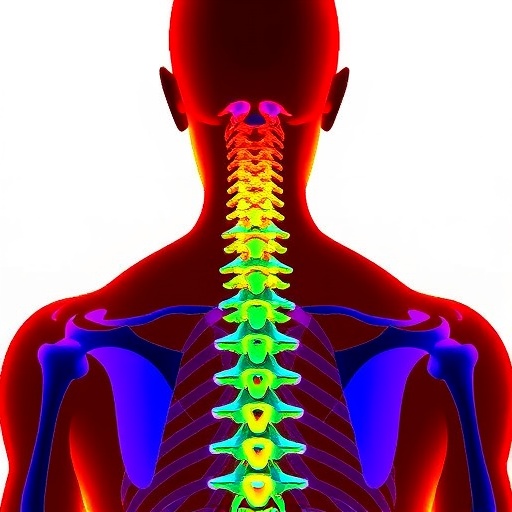Recent advancements in the field of musculoskeletal modeling have led to significant breakthroughs in our understanding of the thoraco-lumbar spine. This area of research has gained momentum due to the increasing global prevalence of spinal disorders, which affect millions of people worldwide. As scientists continue to investigate the complexities of the spine’s biomechanics, new insights have emerged that enhance clinical practices and improve patient outcomes. The latest systematic review conducted by Carpenedo et al. delves into these advancements, highlighting the state-of-the-art techniques and methodologies employed in musculoskeletal modeling of the thoraco-lumbar spine.
The thoraco-lumbar spine, which serves as a critical support structure for the upper body, is subject to various mechanical stresses and strains. As such, its intricate biomechanics is essential for maintaining structural integrity and facilitating movement. The systematic review presented sheds light on the need for accurate and reliable musculoskeletal models that can simulate the unique mechanical behavior of this region of the spine. Such models help clinicians better understand spinal mechanics, leading to improved diagnostic approaches and treatment strategies.
One of the key findings of the review is the increasing use of finite element analysis (FEA) techniques. FEA allows researchers to simulate complex loads and material properties by breaking down the spine into smaller, manageable elements. This method reveals critical insights into how various factors—such as age, injury, or degenerative conditions—can impact spinal biomechanics. The ability to visualize stress distribution and deformation within the thoraco-lumbar spine not only assists in understanding the consequences of injuries but also aids in tracking the progress of rehabilitation.
Moreover, advancements in computational power and techniques have enabled the development of more sophisticated multi-body dynamic models. These models simulate the movement of the entire body, which allows for studying the coupled dynamics of the spine in relation to other body segments. By integrating ground reaction forces and muscle activities, these models facilitate a more holistic understanding of how the thoraco-lumbar region interacts with the rest of the musculoskeletal system. As a result, clinicians can obtain a clearer picture of movement mechanics, ultimately informing treatment pathways and surgical interventions.
The review also discusses the importance of incorporating patient-specific parameters into musculoskeletal models. Traditional models often relied on generic representations of spine anatomy, which limited their clinical relevance. Recent studies have shifted the focus to personalized modeling approaches, which utilize patient data—such as imaging studies and clinical measurements—to create more accurate representations of individual spinal geometries. Such patient-specific models offer a powerful tool for predicting how specific interventions will impact a patient’s unique anatomical and mechanical characteristics.
Another significant concern highlighted in the systematic review is the translation of lab-based findings into real-world clinical applications. While laboratory studies provide invaluable insights into spinal mechanics, the applicability of such research to the complexities of everyday life remains a challenge. To address this gap, researchers are now exploring the integration of musculoskeletal models with wearable technology. Such innovations promise to provide real-time biomechanical data, enabling continuous monitoring of spinal health and individualized feedback for patients during rehabilitation.
The impact of these advancements extends beyond academic research to practical clinical applications. For instance, improvements in musculoskeletal modeling have implications for surgical planning. Surgeons can utilize detailed simulations to foresee the outcome of different surgical approaches, evaluate potential risks, and establish patient-specific protocols. This not only improves surgical precision but also enhances patient safety and recovery outcomes.
In addition to their clinical applications, musculoskeletal models can assist in developing prevention strategies. By identifying how certain movement patterns may predispose individuals to spinal injuries, practitioners can devise targeted exercise and conditioning programs aimed at minimizing the risk of injury. This proactive approach to spinal health is gaining traction within the medical community as an effective means of addressing the growing prevalence of spinal disorders.
The review emphasizes the interdisciplinary nature of musculoskeletal research. Collaboration between biomechanists, clinicians, engineers, and computer scientists is paramount in driving forward the development of innovative modeling techniques. Such partnerships enhance the relevance and accuracy of research findings, while also fostering the translation of science into practice. By working together, specialists can address complex questions surrounding spinal mechanics and promote advancements that directly benefit patients.
Regulatory considerations also play a critical role in the incorporation of novel musculoskeletal models into clinical practice. As the technology and methodologies evolve, it is essential to establish standardized protocols and guidelines to ensure safety and efficacy. The review advocates for collaborative efforts among regulatory bodies, researchers, and healthcare providers to establish benchmarks that guide the implementation of these advanced modeling techniques in clinical settings.
Furthermore, the review highlights how public awareness and education on spinal health can complement advancements in research and practice. Greater understanding of spinal biomechanics among patients encourages proactive engagement in their own health management. Educational initiatives aimed at promoting awareness of spinal health can empower individuals to recognize the importance of preventive measures and seek timely medical intervention when necessary.
In conclusion, the systematic review by Carpenedo et al. highlights transformative advancements in musculoskeletal modeling of the thoraco-lumbar spine. By integrating advanced computational techniques with patient-specific approaches, researchers are unlocking new avenues for understanding spinal biomechanics. The implications of these advancements are profound, ranging from improved surgical outcomes to enhanced preventative care strategies. As the field continues to evolve, ongoing collaboration among multidisciplinary experts will undoubtedly drive further progress, ultimately leading to better spinal health for individuals around the world.
Subject of Research: Musculoskeletal modeling of the thoraco-lumbar spine.
Article Title: Advances in Musculoskeletal Modeling of the Thoraco-Lumbar Spine: A Comprehensive Systematic Review.
Article References:
Carpenedo, L., Ignasiak, D., Remus, R. et al. Advances in Musculoskeletal Modeling of the Thoraco-Lumbar Spine: A Comprehensive Systematic Review.
Ann Biomed Eng (2025). https://doi.org/10.1007/s10439-025-03818-8
Image Credits: AI Generated
DOI: 10.1007/s10439-025-03818-8
Keywords: Musculoskeletal modeling, thoraco-lumbar spine, finite element analysis, patient-specific modeling, spinal biomechanics.




